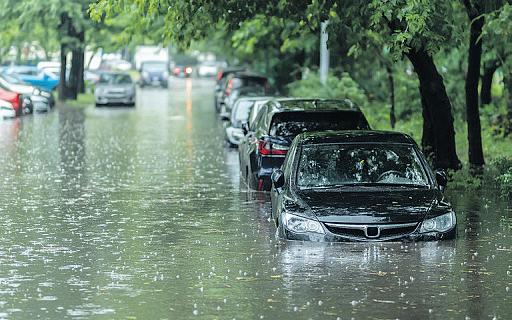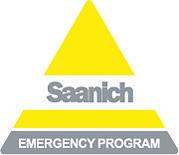








Earthquake Important things to remember during an earthquake In the Event of a Tsunami Make an Emergency Plan Local Emergency Program Contact Home And Shelter-In-Place Kit Grab & Go Bags Information provided by the Local Government Emergency Program Advisory Commission, please visit prepareyourself.ca for more EMERGENCY IN CASE OF May 2, 2023 EMERGENCY APREPAREDNESS: WERESPONSIBILITY ALL SHARE
Recently, B.C. has coped with a continuing pandemic, a record-breaking heat dome and a devastating atmospheric river event. These emergencies were felt across the province and are having lasting effects on those still recovering. As we look ahead, we know that a changing climate is causing more frequent and destructive weather events. Everyone has a role in emergency preparedness and now is the time to ensure you’re prepared.
British Columbia is working on an all-ofsociety approach to disaster risk reduction. That means everyone, in every organization, including individual citizens has a role to play in emergency preparation, response and recovery. Together, we can plan ahead, improve our response to these events and recover with a

focus on reducing potential damages in the future. When everyone takes steps to getting prepared, communities can minimize damage and recover faster. Individual citizens have a lot of power in determining how well their communities cope with emergencies.
GET PREPARED



Getting your household ready can seem like a daunting, expensive task. But it doesn’t have to be. Visit PreparedBC.ca to learn more about the 3-step process and access free resources, including fill-in-theblank plans.











First, know the hazards you face. There are 10 major hazards we face in B.C. and they vary




across our landscape. Some are widespread like severe weather, power outages and wildfire, while some are regional like tsunamis and avalanches. Find out what hazards you face where you live, work, and travel. Check out our interactive hazard map at PreparedBC.ca/hazards
Second, make your plan. Planning is free and easy with our fill-in-the-blanks guide. Having a plan means your whole household will know where to go, what to do, and have vital information at their fingertips during an emergency. Emergencies are high-intensity and stressful – you can help lessen fear and respond with confidence simply by taking 30 minutes to make your plan and ensure everyone has a copy in their grab-and-go bag or saved to their devices. Start your planning at PreparedBC.ca/emergencyplan

Third, gather your supplies. This step doesn’t have to be costly. You’ll want an emergency kit if you need to shelter in place after an earthquake or when a pandemic has you isolating at home. Grab-and-go bags are there for when you need to leave quickly and won’t have time to pack. Use an old backpack or duffle bag and slowly add supplies starting with what you already have on hand. Add items you don’t have on
hand to your grocery list and pick up extra items when they’re on sale. For non-grocery items, try the local thrift and dollar stores. If gathering your supplies is too time-consuming and your budget allows, buy one pre-made. Don’t forget to include the supplies unique to your household’s needs – including your pets! Visit PreparedBC.ca/emergencykit for the full list of supplies.
Getting your household prepared doesn’t have to happen in one day. Stick to our 3-step process and start with one small part today. Get everyone involved and before you know it, you’ll be prepared and feel more confident about how your household will respond in an emergency. Want to learn more? Follow @PreparedBC on Facebook and Twitter
TIMES COLONIST | IN CASE OF EMERGENCY 2 | TUESDAY, MAY 2, 2022
PreparedBC is B.C.’s emergency preparedness education program and we are here to help you get ready for the hazards we all face
BE RESCUE READY
As the most mountainous region of Canada, it should come as no surprise that British Columbia is also the province with the highest number of search and rescues.
In addition to enticing scenery, easy access to this mountainous terrain often gives outdoor enthusiasts a false sense of security that can mislead hikers and backcountry adventurers into areas they’re not prepared or equipped for. Every day, people innocently misjudge their skills, gear and conditions and find themselves lost or injured.
On average, more than 1,500 times a year, search and rescue (SAR) groups in B.C. are called out to assist outdoor enthusiasts. Based on data collected by the BC Search and Rescue Association (BCSARA), these incidents are primarily due to injury, getting lost or disoriented or exceeding the abilities of the recreationalist.


Decisions made before leaving home could have prevented many of these SAR callouts or lessened the amount of suffering – simply by doing a little planning and preparedness ahead of time. To help reduce the number and severity of SAR responses, BCSARA asks all recreationalists to make sure they have completed the following three Ts (trip planning, training and taking the essentials).
TRIP PLANNING
Leaving a trip plan or letting others know where you are going and what your plans are provides extremely valuable information to search groups if you end up needing rescue.
• Plan your travel route that includes the actual trail (s) and locations you
will be going to
• Watch a trail specific safety video
• Know the terrain and conditions
• Check the weather
• Fill out an AdventureSmart Trip Plan
TRAINING
Many outdoor recreationalists commit to activities that are beyond their skill level or beyond the conditions they are prepared for. What starts out as a warm sunny hike can end up in deep snow at the summit of some of B.C.’s trails.

• Obtain the knowledge and skills you need before heading out.
• Take a free training course or enroll in a free instructional webinar.
• Know and stay within your limits.
• Spend some time inside watching BCSARA’s YouTube channel video library.
TAKING THE ESSENTIALS
No matter what the activity, always be ready for an unexpected night outdoors. It takes time to locate lost persons and nightfall will increase that search time. Carry a backpack with these essential items and don’t forget to add in items for seasonal conditions.
1. Flashlight or light source
2. Fire making kit
3. Signaling device (i.e., whistle, hand mirror)
4. Extra food and water
5. Extra clothing
6. Navigational/communication devices
7. First aid kit
8. Emergency blanket/shelter
9. Pocket knife
10. Sun protection
For a full description of the essentials, please visit this AdventureSmart webpage.

IN AN EMERGENCY
If you find yourself in difficulty, call 911 as soon as possible. In many cases, search teams have been able to ping a lost person’s cellphone and guide them back to their trail just by talking to them by phone. There is no charge for search and rescue in B.C.
The 911 operator will dispatch the RCMP and they will request search and rescue (SAR teams can only be activated by certain requesting agencies). When your phone makes an emergency 911 call, it will connect with any cell tower in range, even if it is not from your network provider.
If you are using a satellite phone, you will not be able to dial 911 and will need to call 1-800-663-3456, which will connect you to an emergency coordination centre. Some phone models, such as the iPhone 14 and higher, are equipped with a satellitebased SOS feature. This is especially helpful when out of cell range. Consider purchasing a phone that offers this option or a personal locator beacon if you are a regular outdoor recreationalist.
Don’t forget to learn how to obtain your smart phone’s GPS reading and ensure your location services are turned on. During the 911 call, you can relay these coordinates to the operator, who will then pass it on to search crews. If you don’t know how to find this information yourself, authorities and search crews have the ability to get an accurate fix on your
device’s location, without any further action or input on your part.
If you are worried about a friend or loved one who is overdue, do NOT wait to call 911. Call as soon as you are concerned. Search and rescue teams require time to deploy and, the earlier they know, the faster they can respond.
SHELTER IN PLACE
If you’re waiting for rescue and your phone rings, please answer it even if you don’t recognize the number. It may be search and rescue calling. Stay calm and maintain a positive attitude. Remember to STOP (stop, think, observe and plan) and don’t move from your location. If you move, it will increase search time and the amount of area that search teams have to cover.
Finally, signal for help, especially if you hear or see a helicopter or people. Use whistle blasts x 3, mirror flashes x 3, horn blasts x 3, signal fires x 3 or rock piles x 3 to signal distress. You can also create a ground-to-air symbol by making the letter “V” or “SOS”, at least three meters in length.
Be rescue ready
As freezing levels rise and warm weather approaches, it’s a great time to think about what you can do to reduce the search and rescue call volume for B.C.’s 3,400 SAR volunteers. Small measures like leaving a trip plan, taking some free training and packing the essentials can go a long way towards keeping everyone safe.
As you head outdoors, make sure you’re rescue ready!
To learn more, visit https://bcsara. com/outdoor-education/
ADVERTISING FEATURE TUESDAY, MAY 2, 2022 | 3

The Langford Emergency Program would like to congratulate and thank Langford’s ESS dedicated volunteers in recognition of Emergency Preparedness Week.


We appreciate and thank all our Saanich Emergency Program volunteers for their dedication to our community. Your commitment, knowledge and enthusiasm make a positive difference every day. @SaanichEP
1.
CENTRAL SAANICH Emergency Program emergencyprogram@csaanich.ca


250-544-4238
Make a Plan, Build a Kit and Stay informed by signing up for Saanich Peninsula Alert www.centralsaanich.ca/spa





This Emergency Preparedness Week, Esquimalt Fire Rescue wants to thank all the volunteers who step up when it comes to preparing our communities for disasters and emergencies.

The North Saanich Fire Department would like to thank all of our dedicated volunteers for their time, effort and commitment to keeping our community safe. 250-656-1931
NorthSaanichFire.ca

2.
The Sidney Emergency Program extends its sincerest appreciation to our volunteers who continue to exceed expectations and provide exceptional service. Thank
3.
Be Prepared, Not Scared Know the Risks Have a Plan Have your Kits Know Your Neighbours Oak Bay Emergenc y Program obep@oakbay.ca | 250-592-9121 | w w w.oakbay.ca Sign-up
y notific ation system oakbay c a/aler ts ← ← ← ← ← Oak Bay Fire Dept
@SaanichFire May is Emergenc y Preparedness Month
for Oak Bay ’s emergenc
you!
@SidneyFireDept
COLWOOD EMERGENCY PROGR AM Get Prepared
Know your
hazards
Make a
plan
colwood.ca westshorealert.ca 250-478-8321
Gather your supplies
PUBLIC SAFETY COMMUNICATIONS ROLLING OUT TO PORT RENFREW

With the highly anticipated approach of warmer weather and longer days, Highway 14 from Sooke to Port Renfrew will see a rapid increase in the number of outdoor enthusiasts and tourists traveling to and through these west coast communities. Thanks to a provincial push to bring cellular service to this underserved area, Capital Region Emergency Service Telecommunications Inc. (CREST), has successfully negotiated a co-location agreement with Rodgers Communications (Rogers). This agreement enables CREST to
ABOUT CREST:
extend their public safety network from Otter Point to Port Renfrew making life safer for residents, for emergency responders and for visitors to this well-traveled corridor. For Otter Point, Shirley and Port Renfrew Fire Departments, RCMP and BC Ambulance Service, this is welcomed news.
Otter Point is the first community in this expansion of services initiative to experience the public safety benefits of the CREST system, and Otter Point Fire Department, Chief John McCrea is pleased. “I would like

to thank all the CREST team who worked on the new tower in Otter Point! After the tower came online, we did some testing ourselves on the communications from the 8400 block West Coast Road, west, all the way to Muir Creek. Our testing on the CREST network verifies that there are significant improvements throughout this section of our district. It appears that we now have clear communications throughout this whole area where we had spotty or no communications previously.”


Assuming alignment with BC Hydro’s response times, critical public safety communications will be available just in time for summer along this busy west coast corridor by mid-May bringing service to Shirley, Bear Beach, Minute Creek and Port Renfrew.


More than 3000 first responders and public service personnel rely upon the CREST public safety telecommunications network 24 hours a day, 365 days a year to protect our communities and to keep themselves safe. The CREST network handles more than 10 million transmissions per year, or one call every three seconds. CREST has another colocation agreement with Rogers to address gaps in coverage on the Gulf Islands. Without this critical public safety infrastructure in place, service interruptions and dead zones will continue to challenge emergency responders working in these areas putting them and the public at risk.
Capital Region Emergency Service Telecommunications Inc. (CREST) provides and maintains emergency communications equipment and infrastructure that supports more than 50 emergency response and public service agencies 24/7 throughout the Capital Region. This includes fire departments, police departments, BC Ambulance Services, BC Transit, UVic
security, Victoria International Airport, BC Conservation Officer Service, Legislative Assembly security, municipal bylaw departments and others.
CREST completed a $24.5 million network upgrade in 2020 to a digital network that is a world standard in public safety communications technology. In addition to a suite of enhanced performance features, of paramount importance is the network’s design. The geographic layout of the CREST network responds to our unique island geography with built-in redundancy that strengthens the Capital Region’s ability to be self-reliant in the face of a largescale disaster. While the CREST network allows for interoperability with E-Comm (Emergency Communications for British Columbia Inc.), the network is designed to ensure our region’s emergency response agencies have a dedicated public safety communications system tailored to our island location.
TIMES COLONIST | IN CASE OF EMERGENCY 6 | TUESDAY, MAY 2, 2023
CREST.CA
CREST cabling being installed on one of Roger’s new communications towers.
Capital Regional Distric t
HOW TO STAY INFORMED
■ Do not call 911 unless life-threatening emergency.
■ Emergency officials will rely partly on local media and the Internet to get information to the public.
Cable TV, radio and the Internet are some of the tools that officials will use to help communicate evacuation alerts and bulletins about impending dangers such as severe storms, wildfires and tsunami.
■ After a disaster, officials will provide updates via the media as facts and information are confirmed. Check PrepareYourself.ca or your local authorities websites for updates.
■ Most local media (TV and radio) do not have staff on duty 24/7; therefore, if a disaster occurs during the night, only the stations with staff on duty will be able to broadcast during the first few hours of the disaster. Other stations might bring in staff to provide 24/7 news during the disaster, but that could take hours or days.
■ During a disaster, tune in to local media for news updates via your emergency radio. If you are online, join the conversation on Twitter for regional emergency information from @PrepareCRD and EMBC’s emergency feed @EmergencyInfoBC for provincial information.
■ There will be lots of rumour, opinion and speculation, especially on the Internet. When making decisions for yourself and your family, rely on news that clearly comes from trusted official sources such as local government officials, first responders, utilities and Environment Canada.
■ Become familiar with your local broadcasters, and check periodically which stations have 24/7 live broadcasts. In Greater Victoria, local media include:
• The Q – 100.3 FM @TheQdotFM
• CFAX – 1070 AM @CFAX1010
• CBC Radio One – 90.5 FM @CBCV-FM
• JACK FM – 103.1 FM @Jack1031VIC
• Virgin Radio – 107.3 FM @CHBE-FM
• The Ocean – 98.5 FM @Ocean985
• The Zone – 91.3 FM @TheZone913
• CFUV – 101.9 FM @CFUV
• Local TV Stations
ADVERTISING FEATURE TUESDAY, MAY 2, 2023 | 7
Juan de Fuca Electoral Area
District Sooke Metchosin East Sooke Salt Spring Island Southern Gulf Islands North Saanich Sidney Highlands View Royal Langford Colwood Esquimalt VictoriaOak Bay Central Saanich Saanich MAP PROVIDED BY THE CRD
Cowichan Valley Regional
Local Emergency Programs
The capital region is made up of 13 municipalities and three electoral areas. Each is responsible for its own local emergency program. These emergency programs help support and manage the planning, preparedness and response efforts in your community. You can contact your local program to:
■ Obtain information on emergency preparedness and upcoming workshops and events,
■ Arrange an emergency preparedness workshop for your organization or community group, and
■ Volunteer for local neighbourhood programs such as Emergency Social Services (ESS), Search and Rescue (SAR) and Emergency Radio Communications (Comms).
LOCAL EMERGENCY PROGRAM CONTACT
Keep these local & national emergency numbers handy! For more info: prepareyourself.ca

LOCAL GOVERNMENT WEB ADDRESS PHONE EMAIL
Central Saanich centralsaanich.ca
Colwood colwood.ca
Esquimalt esquimalt.ca
Highlands highlands.ca
Juan de Fuca crd.bc.ca
Langford cityoflangford.ca
Metchosin metchosinemergencyprogram.ca
North Saanich northsaanich.ca
Oak Bay oakbay.ca
Saanich saanich.ca
Salt Spring Island crd.bc.ca
Sidney sidney.ca
Sooke sooke.ca
Southern Gulf Islands crd.bc.ca
Victoria victoriaready.ca
View Royal viewroyal.ca
Twitter

PrepareCRD @PrepareCRD
Central Saanich @CSaanichFire
Colwood @cityofcolwood
Esquimalt @EsquimaltBC
Highlands @HighlandsEP
Juan de Fuca @JdFemerg
ADDITIONAL RESOURCES
GENERAL INFORMATION
■ BC Emergency Health Services (formerly BC Ambulance) – bcehs.ca

■ BC Centre for Disease Control – bccdc.ca
■ BC Hydro Outages – bchydro.com/outages
■ BC Ministry of Health – gov.bc.ca/health
■ BC RCMP – bc.rcmp–grc.gc.ca
■ BC Wildfire Service – bcwildfire.ca
■ Disability Alliance BC – disabilityalliancebc.org
■ Drive BC – drivebc.ca
■ Emergency Info BC – emergencyinfobc.gov.bc.ca

■ Emergency Management BC – gov.bc.ca/PrepareBC
250.544.4238 emergencyprogram@csaanich.ca
250.478.5999 emergencyprogram@colwood.ca
250.414.7120 emergency.program@esquimalt.ca
250.474.1773 lhilton@highlands.ca
250.642.8105 jdfepc@crd.bc.ca
250.478.9555 firechief@cityoflangford.ca
250.478.1307 firechief@metchosinfire.ca
250.656.1931 emergprogram@northsaanich.ca
250.592.9121 obep@oakbay.ca
250.475.7140 sep@saanich.ca
250.537.1220 ssiepc@crd.bc.ca
250.656.2121 firedept@sidney.ca
250.642.5422 info@sooke.ca
866.308.6160 sgiepc@crd.bc.ca
250.920.3373 emvic@victoria.ca
250.479.7322 emergencyprogram@viewroyal.ca
Langford @LangfordFire
Metchosin @MetchosinEOC
North Saanich @dns_fire
Oak Bay @OakBayFireDept
Saanich @SaanichEP
SGI @SGIEmergPrg
Sidney @SidneyVFire
Sooke @Sookeca
SSI @SSIEmergency
Victoria @CityOfVictoria
View Royal @VRFD
■ Emergency Preparedness in the Capital Region – PrepareYourself.ca
■ Emergency Social Services BC – 2.gov.bc.ca/gov/content/safety/emergencypreparednessresponse-recovery/volunteers/emergency-social-services
■ Environment Canada weather – weather.gc.ca
■ Fortis BC – fortisbc.com

■ Island Health – viha.ca
■ Ministry of Environment – gov.bc.ca/env
■ National Tsunami Warning Centre – tsunami.gov
■ Natural Resources Canada – nrcan.gc.ca
■ Public Safety Canada – getprepared.gc.ca
■ ShakeOutBC – ShakeOutBC.ca
■ University of Victoria Weather Network – victoriaweather.ca
TIMES COLONIST | IN CASE OF EMERGENCY 8 | TUESDAY, MAY 2, 2023

























































